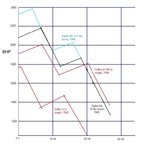- Thread starter
- #81
better power to weight ratio where?
for takeoff?
for 10,000ft
for 25,000ft?
Here is a power chart for a Sabre IIa engine.
http://www.wwiiaircraftperformance.org/tempest/sabrecurve.jpg
Note that the almost 2400 hp at 4000ft(?) decreases to 1600hp at just over 22,000ft. Also note that this is with 400mph of ram into the carburetor intake which means that power levels are going to be down several thousand feet for climb performance.
A Griffon 61-69 was rated at about 2000-2010hp at 6750-7000ft in low blower at 21lbs boost and 1810-1820hp at 21000ft in hi blower. At any altitude over about 1900ft it is making more power and it weighs about 83% of what the Sabre does. on a power to weight basis they are often within about 1% of each other until those altitudes are over 20,000ft. Then then the Griffon runs, not walks away, having a better power to weight ratio by 30% or more .
Many thanks for the link; guess next time I should put more effort to find stuff on the 'net by myself
Re. 2-stage engines for Spitfire, I was commenting onto '2-stage engines for Spitfire' - and only 2-stage engine is Spit (operative squadrons) in 1943 was Merlin. Griffon was single stage engine back then, hence my sentence about greater power-to weight ratio of the plane.
Props and radiators/oil coolers have to be sized for the best power condition (worst cooling load, the extra 350-400hp of the Sabre ?. High altitude cooling may be a problem for the Griffon?)
Agreed; so the Sabre would have 'more' coolers, but no intercoler - slightly more drag than XII, but less than IX XIV?
added: the chart you've provided the link is for Tempest (Sabre uses +11 lbs boost under FTHs, with 150 grade fuel) - not available in 1943?
Last edited:

